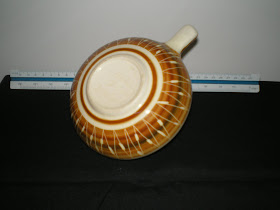Look into any Australian family’s cupboards any time between the 1920s and the 1960s and you would be sure to find wares from the Crown Crystal Glass Company, who had a virtual monopoly. They produced some distinctly Australian patterns. Most (although not all) of the early designs are Crown’s own, reflecting the Australian cultural obsession of the first half of the 20th century with native flora and fauna. Their quality did not reach that of American pressed glass until after the second-world war, and their production values could be quite low, but that is part of their appeal.
Pyrex is a name for glassware introduced by Corning Incorporated in 1915. Originally Pyrex was made from borosilicate glass. In the 1940s the composition was changed for some products to tempered soda lime glass that is now the most common form of glass used in glass bakeware and has a higher mechanical strength so is less vulnerable to breakage when dropped (the main cause of breakage in glass bakeware).
These ramekins are made from a product called Pyroceram. The manufacture of this material involves a process of controlled crystallization. NASA classifies it as a “Glass-Ceramic” product. Glass Ceramic materials share many properties with both glass and ceramics. They have an amorphous phase and one or more crystalline phases and are produced by a “controlled crystallization” in contrast to a spontaneous crystallization that is not usually wanted in glass manufacturing. Glass ceramics usually have between 30% [m/m] and 90% [m/m] crystallinity and yield an array of materials with interesting thermomechanical properties.
Pyroceram is a material developed and trademarked by Corning Glass in 1953. Capable of withstanding temperatures of up to 450 degrees C (840 F), its development evolved from Cornings’ work in developing photosensitive glass. Corning credits S Donald Stookey with its discovery; while he was conducting research he noted that an accidentally overheated fragment of glass resisted breakage when dropped.
Another Australian Pottery, Studio Anna was also catering for the cookware market at the same time. Introduced by owner Karel Jungvirt around the early 1960s, possibly as an Australian answer to Corning Ware (which came out in 1958), a range of decorated cookware he called Pyro-Ceracraft was developed. Available in a wide selection of designs and described as oven tableware, this range of heat resistant ceramics included casserole dishes, pie dishes and ramekins and was designed to be attractive enough to be brought straight from the oven to the dinner table.
Glass ceramics are mostly produced in two steps. Firstly, a glass is formed in a glass manufacturing process. The glass is then cooled down and is then reheated in a second stage. In this heat treatment the glass partly crystallizes. In most cases nucleation agents are added to the base composition of the glass-ceramic. These nucleation agents aid and control the crystallization process. Because there is no pressing and sintering, glass-ceramics have no pores , unlike sintered ceramics. When a liquid crystallizes during a cooling phase of a process, the molecules organize from a primary nucleus to form complex structures. These structures continue to grow until they impinge on neighbouring molecules, then they stop. Properties of the item depend on the size of the molecular structures.
For crystal growth to start, a primary process called nucleation has to occur. This is the focal centre around which the molecules can organize themselves. The secondary process of crystal growth follows nucleation. A nucleation agent is a foreign body added to create a new surface on which crystal growth can happen. Typically this phase takes the form of an agent to have a good match with the growing crystal
The 2nd World War saw production of domestic ware drop to fairly low levels at Crown. Most of their production was servicing the war effort, including contracts for the US Navy. After the war, some of their early patterns made a comeback, but much of their production turned to ceramic glazed, colourful but streamlined and less decorative items, as was the fashion in the 1950s. Much of their glass was mould-blown or involved hand tooling, but this ceased in 1968.
During the 1950s and 1960s tableware production continued, especially for homes, hotels restaurants and milk bars. In 1963 Crown Crystal became a division of Australian Consolidated Industries (ACI) which set up a joint venture with American company Crown Corning in 1968, known in Australia as Crown Corning Ltd. In 1998 ACI became an affiliate of Owens-Illinois in the USA, one of the world’s largest manufacturers of glass containers and a leading glass equipment manufacturer.
Crown Corning is now known as Crown Commercial Pty Ltd and continues to produce a large range of glassware for both commercial and domestic markets. Ramekins of this type are not in the range. The Crown Crystal Glass Company merged with the American company Corning in 1972 to become Crown Corning.
There is now quite a bit of evidence that Crown Crystal was copying patterns from overseas after 1932. Copied patterns have confused collectors so be careful on Internet auction sites. In a case of what goes around comes around, Australian glass patterns are now also being copied, so be doubly careful. For more information, look at http://www.ozcrowncrystal.com/ because that is where a lot of this has come from. Glass is not my area and they have some very interesting information.


